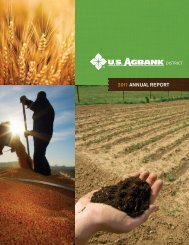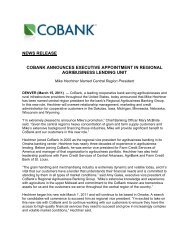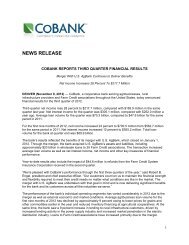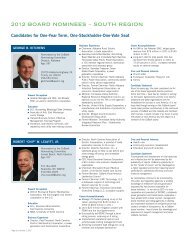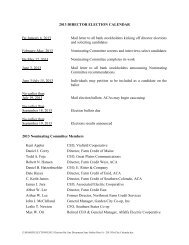Annual Report - CoBank
Annual Report - CoBank
Annual Report - CoBank
You also want an ePaper? Increase the reach of your titles
YUMPU automatically turns print PDFs into web optimized ePapers that Google loves.
The fair value of our derivative financial instruments isthe estimated amount to be received to sell a derivative assetor paid to transfer or extinguish a derivative liability in activemarkets among willing participants at the reporting date.Estimated fair values are determined through internal marketvaluation models. These models incorporate benchmarkinterest rate curves, volatilities, counterparty credit quality,and other inputs that are observable directly or indirectly inthe marketplace. We compare internally calculated derivativevaluations to broker/dealer quotes to substantiate the results.All financial models used for the determination of the fairvalue of financial instruments in the financial statements or forindependent risk monitoring purposes are periodicallyreviewed and validated in accordance with our policies.The degree of management judgment involved indetermining the fair value of a financial instrument isdependent upon the availability of observable market inputs.For financial instruments that trade actively and haveobservable market prices and inputs, there is minimalsubjectivity involved in measuring fair value. Whenobservable market prices and inputs are not fully available,management judgment is necessary to estimate fair value. Inaddition, changes in market conditions may reduce theavailability of market prices or observable data. For example,reduced liquidity in the capital markets or changes insecondary market activities could result in observable marketinputs becoming unavailable. When market data is notavailable, we use valuation techniques requiring moremanagement judgment to estimate the appropriate fair valuemeasurement. Changes in assumptions could affect the fairvalues.At December 31, 2011, approximately 22 percent of totalassets, or $14.1 billion, consisted of financial instrumentsrecorded at fair value. Approximately 99 percent of thesefinancial instruments used valuation methodologies involvingmarket-based or market-derived information to measure fairvalue. The remaining 1 percent of these financial instrumentsis measured using model-based techniques, constituting ourentire asset-backed securities portfolio. At December 31,2011, approximately 2 percent of total liabilities, or$939.0 million, consisted of financial instruments recorded atfair value.Recent Accounting PronouncementsIn April 2011, the Financial Accounting Standards Board(FASB) issued guidance clarifying when a loan modificationor restructuring is considered a troubled debt restructuring.The FASB’s guidance provides criteria that a lender shouldevaluate in determining whether a borrower is experiencingfinancial difficulties and when a restructuring constitutes aconcession. For nonpublic entities, the guidance is effectivefor annual periods ending on or after December 15, 2012,including interim periods within those annual periods. Earlyadoption is permitted. The adoption of these provisions is notexpected to have a material effect on our consolidatedfinancial position, results of operations or cash flows.In May 2011, the FASB issued guidance clarifying certainaspects of fair value measurement and disclosurerequirements. The guidance is effective prospectively forreporting periods (including interim periods) beginning afterDecember 15, 2011. Early adoption is not permitted. We willadopt these provisions in 2012; however, they are notexpected to have a material effect on our consolidatedfinancial position, results of operations or cash flows, but areexpected to result in additional fair value disclosuressurrounding our Level 3 inputs, which are discussed inNote 12 to the accompanying consolidated financialstatements.In June 2011 and in December 2011, the FASB issuedguidance which revises the manner in which entities presentcomprehensive income in their financial statements. The newguidance requires entities to report components ofcomprehensive income in either (1) a continuous statement ofcomprehensive income; or (2) two separate but consecutivestatements. The guidance does not change the items that mustbe reported in other comprehensive income. These provisionsare effective for fiscal years, and interim periods within thoseyears, beginning after December 15, 2011. Early adoption ispermitted. We will adopt these provisions effective March 31,2012. The adoption will not have an effect on our consolidatedfinancial position, results of operations or cash flows;however, it will result in changes to the presentation ofcomprehensive income.In December 2011, the FASB issued guidance creatingnew disclosure requirements about the nature of an entity’srights of setoff and related arrangements associated with itsfinancial instruments and derivative instruments. Thedisclosure requirements are effective for annual reportingperiods beginning on or after January 1, 2013, and interimperiods within those annual periods, with retrospectiveapplication required. We will adopt these provisions effectiveMarch 31, 2013. The adoption of these provisions is notexpected to have a material effect on our consolidatedfinancial position, results of operations or cash flows.<strong>CoBank</strong> 2011 <strong>Annual</strong> <strong>Report</strong>61






